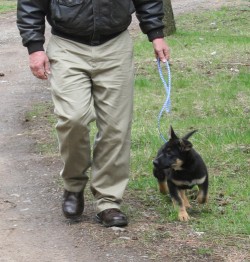Leash Training A Puppy
Leash Training A Puppy
Over the years, we at Candle Hill Shepherds have found that a little insight into leash training your puppy can go a long way to smoothing out your new relationship.
There are three rules to remember when leash training a puppy:
1. Be Gentle
2. Be Kind
3. Remember you are dealing with a Baby
If you keep these three Bs in mind, and work consistently, you will be amazed at what your puppy can learn over time. These little guys are smart. But always keep in mind that they not only have to learn new behaviors, they also have to translate your intentions and their actions across a terrific divide; from the dog world to the human.
Give the puppy time to figure all this out. For a puppy a leash is a big deal. It is not natural. His movements are restricted and he does not know why. This might be a danger, like being caught in a bear trap, only it’s around his neck! You might look down and get frustrated with his actions, “Hey, this is no big deal.” Well to Him it can be new and scary. He will need time to figure out what you can see at a glance.
Until you have moved quite a way along in leash training, don’t expect to actually cover lots of ground. The goal should not be to get somewhere physically with the dog, but rather mentally. There will be lots of stopping while he thinks about his situation, and what to do about it. This is especially true of leash tangles.
Having stepped over a leash and gotten it wrapped around his legs, the puppy may well be presented with an engineering problem that is simply beyond his stage in life. With practice, he will learn how to stay clear of tangles, how to step out of a leash snare and how to walk in a position beside you that allows for continued freedom of movement. But all this takes experience and repetition. Just expect that for awhile, you are going to have to be the one who is constantly switching hands, stepping over the leash and generally keeping things as untangled as possible.
Walking between your legs (not good on a leash) or right under your feet (not good anytime), works well with a four legged mother dog in nature. Not so much with two legged people. Your feet may have to turn, break rhythm or stop multiple times on even a short walk. Sometimes you can tell an experienced handler by how well he flips the leash over his head or switches hands behind his back. This is just part of your job until the puppy learns what is going on.
Until the puppy has learned the rules of walking on a leash, just expect that he will try to extricate himself by pulling away. Be gentle, be kind, he’s just a baby. That does not mean you give in, but it does mean you give him time to figure out that it is your will, not his, that is going to prevail. NO dragging. NO hard yanks. At the puppy stage, calm steady pressure, quick/fast little tugs, holding the leash short, and directional pressure get the messages down the leash. Just expect that there will be plenty of times that you are going to have to reach down and lower/move the leash/leg so he resume his romp with you. In dog training, always remember that you are the source of all fun for this little guy. The toy is yours, the food is yours, the walk is yours.
And a “romp” it should be. Part of the definition of being a puppy is being new to the world. Expect that he is going to want to explore. This can be good or bad, acceptable or dangerous. Of course you will be the one who decides which direction to ultimately head in. But be kind, understand that so much of the world needs to be examined and sniffed. Especially if you are expecting the puppy to relieve himself on the leash, be sure to allow time for him to sniff. This helps him get in the mood, especially where other dogs have been. But watch him closely because part of his natural examination of the new world is to taste… not acceptable.
Consider that there are three stages you are going to have to pass through:
Stage one: “This is scary.” Primarily gentleness and consistency gets him over this. This can begin as soon as you get your puppy. Progression from here will generally depend on time invested and the age of the dog.
Stage two: “Ok, I’m on the leash but look at that cool thing over there.” Quick little tugs, lots of rewards in the way of praise, directional pressure, holding the leash short and to the left will begin to correct much of the natural wanderlust your puppy has. This stage is never completely left behind. Even grown dogs will test the leash now and again.
Stage three: “So how do we do this in a mutually acceptable manner”? This is where actual healing, maintaining proper head position etc. comes in. As the dog grows older, tugs can become sharper – especially for the German Shepherd. But praise for right actions is never less. Note that healing can begin with hand feeding, using a solid object like a wall or a sofa to line the pup/dog up before he gets his reward. This teaches that by your left leg is a very good/ comfortable place to be.
As always, we at Candle Hill Shepherds want to hear about your experiences with your puppy. Please drop us an email and let us know how you are doing. Tell us about your successes and the problems you might be having. No puppy arrives ready for the Westminster Dog Show. Relax and give it time. The journey is what it’s all about. As much as you can, make it fun, for the puppy and for yourself. Enter into your puppy’s wonder at the new world. They grow up far too quickly. Enjoy this fleeting stage while it lasts.
Michael
Candle Hill Shepherds

